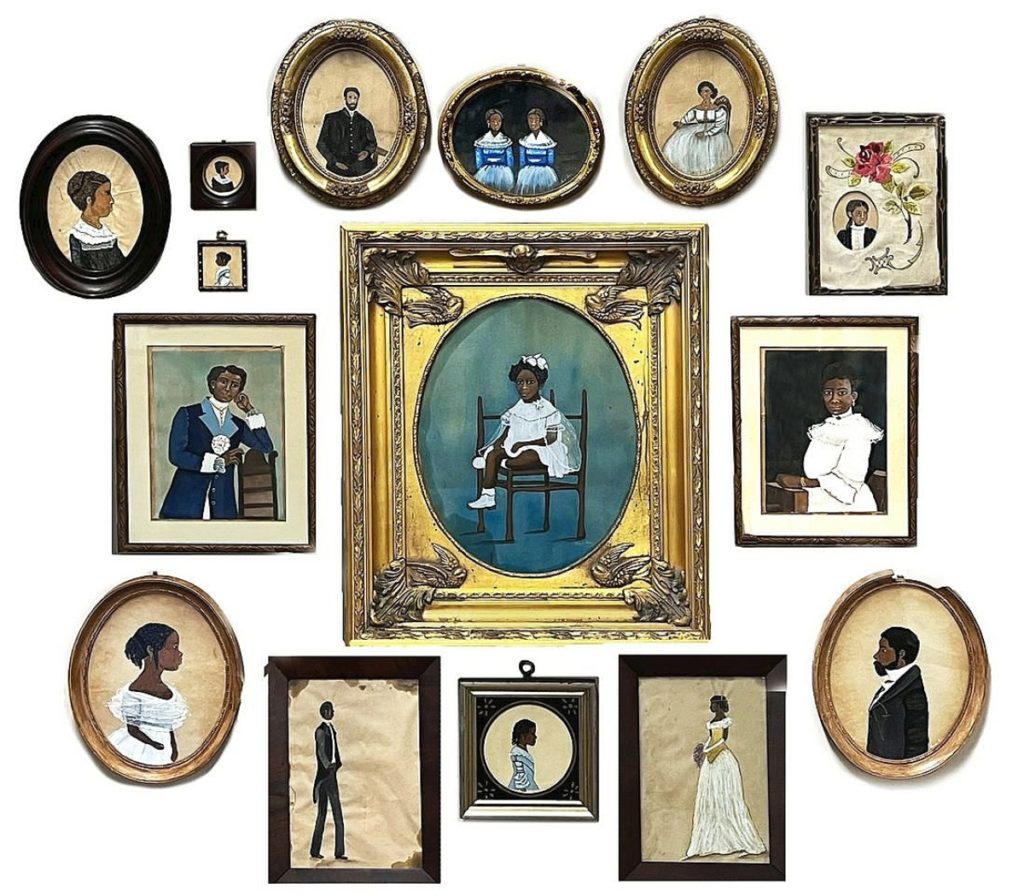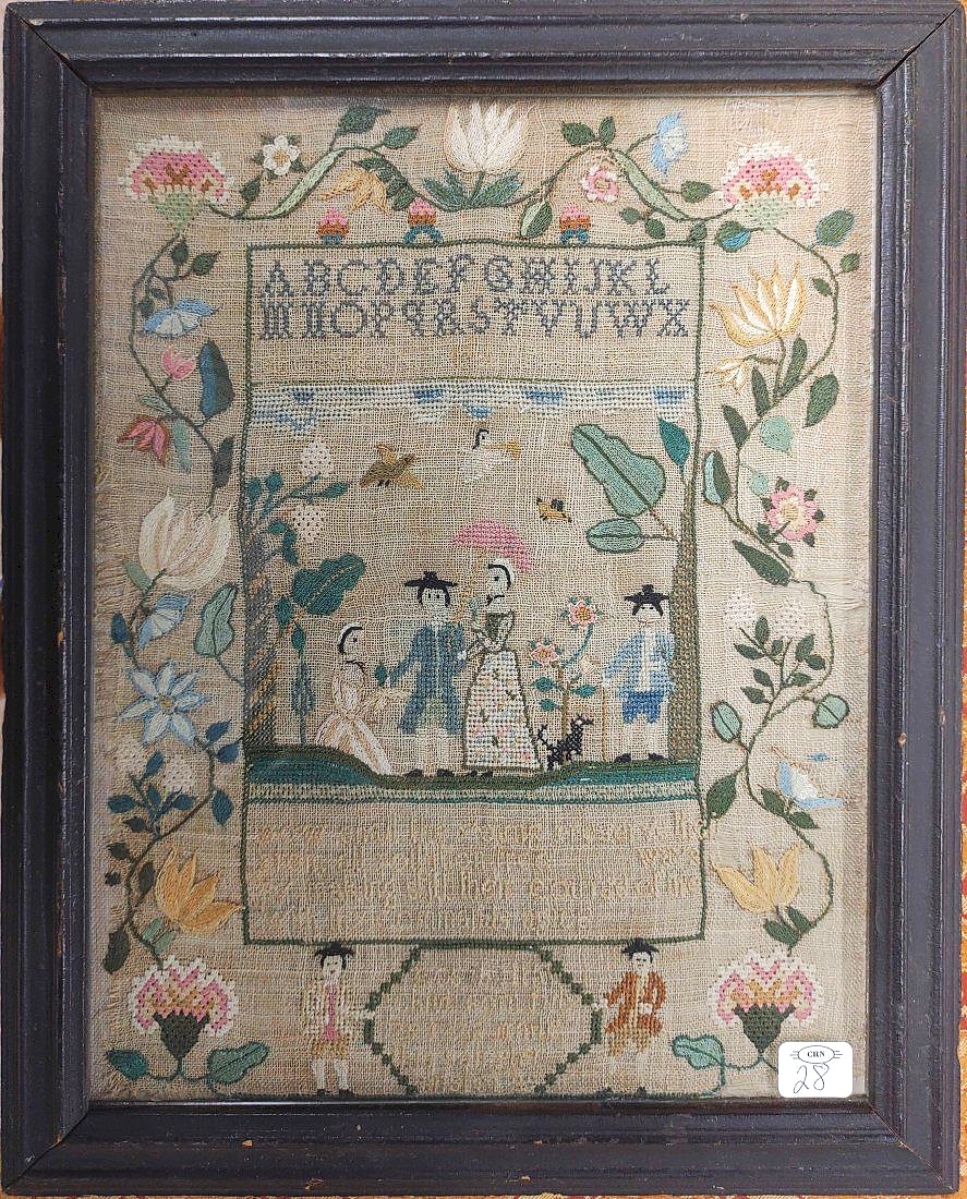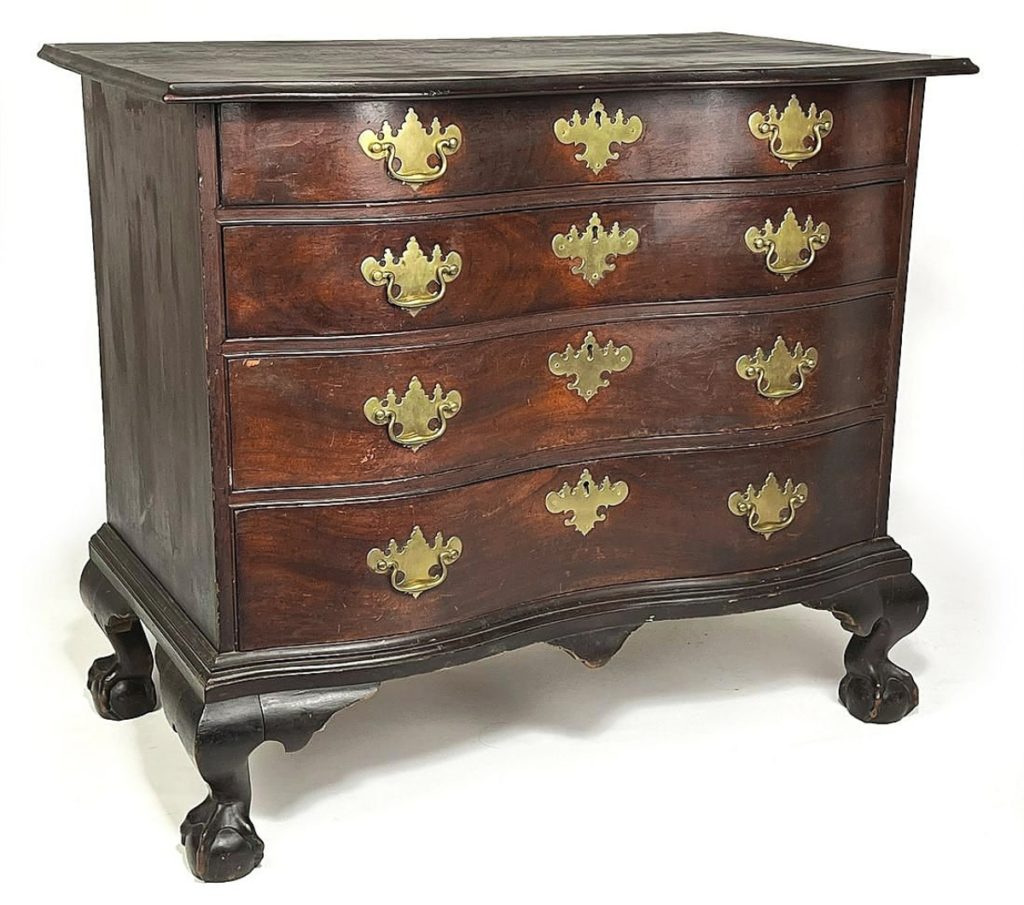Early Furniture, Black Portraits & Surprises Result In $750,000 Sale

The top lot of the day, and a lot with a very interesting backstory, was this group of 15 portraits of an African American family. They were done by Sarah Ray Bryant, whose father had been born into slavery in 1820. The group finished well in excess of the estimate, bringing $73,200.
Review and Onsite Photos by Rick Russack, Additional Photos Courtesy CRN Auctions
CAMBRIDGE, MASS. – Carl Nordblom and partner Karin Philips used the words “extremely eclectic” in their advertising for CRN Auctions’ November 6 sale. That was a fair description, as the sale included early American furniture from the G.W. Samaha collection, Chinese scholar stones, American and European paintings and furniture, art pottery, folk art, decoys, mechanical banks, scrimshaw, Chinese export porcelains, early needlework and more. The Samaha lots were a continuation of the auctions earlier this year of the bulk of the collection. It was a sale of surprises, both in the merchandise itself and with numerous items bringing substantially higher prices than expected.
The top lot of the sale, bringing $73,200 and much more than expected, was a colorful group of 15 watercolor portraits of members of a single African American family; the family history is interesting as well. The untrained artist, Sarah Ray Bryant, was the daughter of Nelson Ray (1820-1882), who was born into slavery. Done in the late Nineteenth and early Twentieth Centuries, many of the portraits were identified. As the story goes, they had originally been found by a real estate developer in Florida in the family home, went through several hands and were eventually purchased by the consignor at an auction in Connecticut of storage lockers for which the rent had not been paid. CRN made the decision to keep the lot together. Nordblom later said the group had been purchased by a collector, although there was interest from multiple institutions.
The family story is an interesting bit of American history. According to the auction’s catalog, Nelson Ray was born in 1820 into slavery in New Orleans, La. His owner stated in his will that upon his death, Nelson was to be given his freedom. However, the release from slavery did not include Nelson’s wife and eight children who remained slaves. When freed, Nelson went West during the Gold Rush and had good fortune, making enough money to return to buy his wife and three of his children. His other children had been sold, and Nelson returned to California with his family. They settled in Placerville where he became a prominent citizen, a landlord and funded the construction of a library. He remained committed to his other children who remained slaves, tracked down their location and, finding them, purchased their freedom.

There was not a lot of needlework in the sale, but bidders liked this Rhode Island needlework sampler by Rosabella Child. Dated 89 (probably 1789), it was done at Mrs Ann Usher’s School, Bristol, R.I., and sold for $19,520. The sampler was accompanied by extensive genealogical information and notes by Betty Ring on the school, as well as notes from a conservator. From the Samaha collection.
Although it was no surprise that the early furniture from the Samaha collection did well, there were some unexpectedly high results within that consignment. Notably, a tall, narrow, one-drawer Hepplewhite stand of New England origin surprised all as it sold for $13,420, far above its $900-1,200 estimate. Nordblom said, “When I saw it in Bill’s house, I thought it was a really unusual form. Bill said he had not put it into our earlier sales of his collection as it was one of his favorite pieces.” The highest priced piece of furniture in the sale also came from the Samaha collection. It was a mahogany Chippendale reverse serpentine chest of drawers from Boston or Salem, which earned $29,280. It retained the original color, original batwing brass and had large claw and ball feet with a shaped apron. Also, expected to do well, which it did, was Massachusetts/Connecticut River Valley, early Eighteenth Century painted chest of drawers, usually referred to as a “Hadley” chest. It was colorfully painted with pinwheels, lobed floral designs, crescents, red wavy lines and dart board designs and stood on high, turned legs. The catalog noted that the paint was not believed to be original. It sold for $11,590. A Pennsylvania tall case clock from the same collection brought $3,965. It had an eight-day brass moon-phase movement and was signed on the dial “Wagstaffe, London.” Thomas Wagstaffe was a Quaker clockmaker working in London from 1756 to 1793 and often made works for Quaker clockmakers in Philadelphia and Newport, R.I. Two Pennsylvania examples are in the Winterthur collection.
CRN’s auctions usually begin with a selection of paintings. While it wasn’t the most expensive painting in the sale, a rustic scene by Herman Herzog (1832-1932) had a quintessentially “American” aesthetic. It depicted a weathered barn and shed, with a small home in the background. Split rail fence divided the barn from a pond or lazy stream with several cows and ducks in the water, all beneath a blue sky with lush, green scenery. It was the sort of painting that would reveal more detail each time you looked at it and realized $9,760. Brandywine River Museum in Chadds Ford, Penn., presented a major exhibition of Herzog’s work in 1992 and published a catalog of his work. At his death in 1932 his family retained a large number of his works, which they began to sell in the 1970s. Examples of his work are now in several museum collections. A pair of paintings by William Aiken Walker (1838-1921) earned $12,200, showing a Black woman in a cotton field with a basket of cotton on her head, and an older Black man in ragged clothes in the same cotton field. Perhaps a father and daughter?
Those who like paintings of dogs would have been attracted to an oil on canvas of a family of French bulldogs with several fat puppies. It earned $4,880 in spite of old repairs. It was done by Susan Hely St John (1834-1913). Although best known as a portrait painter, dogs were often included in her work. An 1875 portrait of an unidentified, well-dressed boy by Joseph John (1833-1877) also had a dog and sold for $3,355. Another young boy, seemingly a street urchin with his dog, painted by John George Brown (1831-1913) reached $5,795. Brown is well known for his scenes of New York’s street urchins.

At $29,280, this Salem or Boston mahogany Chippendale reverse serpentine chest of drawers was the highest priced piece of furniture in the sale. The surface color was original, as were the brasses. From the Samaha collection.
American landscapes included two White Mountains [N.H.] scenes by Frank Shapleigh. A scene along the Thorn Mountain Road in Jackson, N.H., depicting a weathered old house and barn, reached $2,928, and his view of Mount Kearsarge from the Rocky Branch in Bartlett reached $1,952. American marine paintings included four ship portraits by Jerome Howes (b 1955). The State of Maine sidewheeler earned $1,037. One depicting the fully rigged schooner Republic earned $1,464, and another of the fully rigged schooner James Borden brought the same price.
Most of the dozen or so scrimshawed whale’s teeth exceeded their estimates. The one that bidders liked best was just less than 7 inches tall. It depicted a three-masted ship at full sail, below a banner reading “Liberty.” The reverse included a dated banner reading “18 R. H.S. 38” above a compass star. The tooth sold for $5,795. One tooth had a somewhat unusual subject matter: a tropical landscape with lagoon and mountains, and on the reverse was a ship along a coast. The scene was not identified, and the tooth brought $2,440. From the Samaha collection, a scrimshaw and mother-of-pearl document box with an inlaid eagle, elephants and birds, dated 1848, sold for $5,185. It was from the Samaha collection.
After the sale, Carl Nordblom said, “It wasn’t a surprise that the Bill Samaha stuff did well. It was all top-notch material and that’s easy to sell. It’s the mid-range brown furniture that’s hard to move today. That’s really a shame, but it means there are great buys to be had. We sold a really nice Newport Queen Anne mahogany drop-leaf table with an old surface for just $610. That’s hard to explain. But Karin and I were pleased with the results. It’s an auction – some things will always bring more than expected and other things will bring less.”
Prices given include the buyer’s premium as stated by the auction house. For information, www.crnauctions.com or 617-661-9582.
